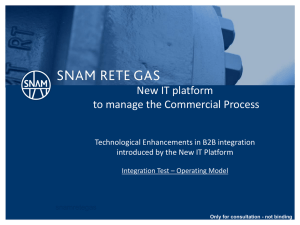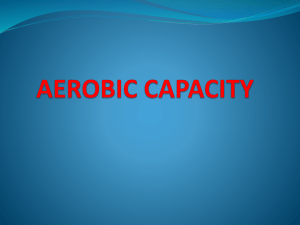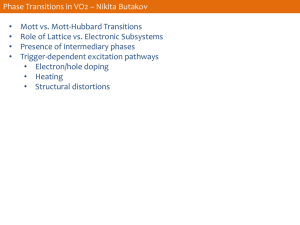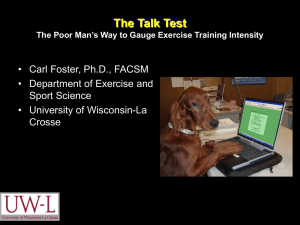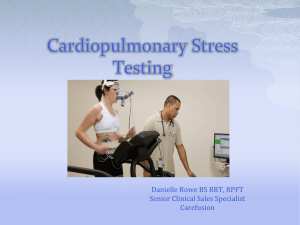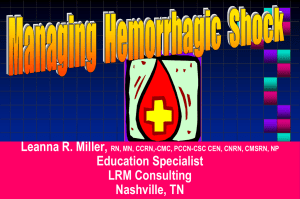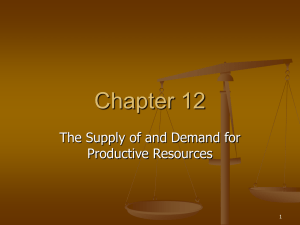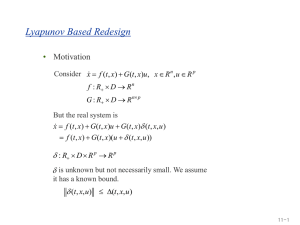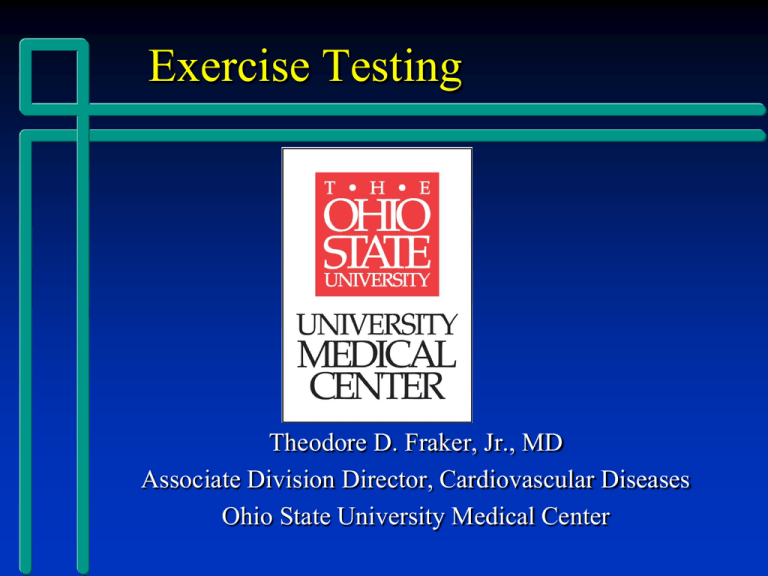
Exercise Testing
Theodore D. Fraker, Jr., MD
Associate Division Director, Cardiovascular Diseases
Ohio State University Medical Center
Why do an exercise test?
To diagnose coronary artery disease
To assess the response to therapy:
– For CAD
– For Hypertension
– For atrial fibrillation
To establish prognosis
To elicit arrythmias
Criteria for a Positive Stress Test:
> 1mm (0.1mV) of ST depression or
elevation (compared to baseline) at 60-80
msec after the j-point
Downsloping ST segments
Horizontal or upsloping ST segments adds
to sensitivity but decreases specificity
Criteria for a Positive Stress Test:
The Problem Stress ECG
Uninterpretable ECG’s:
–
–
–
–
Ventricular Pre-excitation
Paced Rhythms
LBBB
Resting ST depression > 1 mm
Problematic ECG’s:
– Digoxin
– LVH
– Resting ST depression < 1 mm
Pretest Probability of CAD
Gibbons, et al. JACC 2002:40;1531
Pretest Probability of CAD
Framingham 10 year CAD risk calculator:
– http://hp2010.nhlbihin.net/atpiii/calculator.asp?
usertype=prof
– http://www.mdcalc.com/framingham-cardiacrisk-score
Pretest Probability of CAD
ACC/AHA 2013 risk calculator:
– http://my.americanheart.org/professional/StatementsGui
delines/PreventionGuidelines_UCM_457698_SubHomePage.jsp
– Individuals with > 7.5% 10-year risk of cardiac events
should be recommended for moderate or high-dose
statin therapy
– No specific LDLc target in this recommendation
Atherosclerosis Risk
Major Risk Factors:
–
–
–
–
–
–
–
LDL-cholesterol
Low HDL-cholesterol
Family History (male<55; female<65)
Hypertension
Smoking
Diabetes
LVH by ECG
Atherosclerosis Risk
Lesser Risk Factors:
–
–
–
–
–
–
–
–
Age
Male Sex
Elevated Insulin levels
Elevated triglycerides
Physicial inactivity
Postmenopausal status
Obesity (especially central obesity)
Stress & Depression
Atherosclerosis Risk
Thrombogenic Factors:
–
–
–
–
–
–
Lipoprotein (a) [Lp(a)]
Homocysteine
Fibrinogen
C-reactive protein
Plasminogen Activator Inhibitor
Chlamydia pneumoniae infection
Pretest Probability of CAD
Gibbons, et al. JACC 2002:40;1531
Pretest Probability of CAD
Gibbons, et al. JACC 2002:40;1531
Diagnostic Accuracy of the ETT
Gibbons, et al. JACC 2002:40;1531
Useful Data from Stress Testing:
Electrocardiographic:
– Maximum ST depression or elevation
– ST-depression slope (downsloping vs
horizontal)
– Number of leads with ST depression
– Exercise-induced arrythmias
– Time to ST deviation
Useful Data from Stress Testing:
Hemodynamic:
–
–
–
–
–
–
Maximum heart rate
Maximum systolic blood pressure
Maximum double product (HR x systolic BP)
Total exercise duration
Exercise-induced hypotension
Chronotropic incompetence
Useful Data from Stress Testing:
Symptomatic:
– Symptoms of angina or severe SOB
– Time to exercise-induced angina
– Time to exercise-induced SOB
The Rate-Pressure Product
Low: < 200 x 100
Moderate: 200-300 x 100
High: > 300 x 100
The rate-pressure is a surrogate for maximum oxygen uptake
Borg Scale: Rate of Perceived Exertion
Indications for Terminating ETT
Fall in BP > 10 mm Hg when accompanied
by signs of ischemia
Moderate to severe angina
Ataxia, dizziness or near syncope
Technical difficulties with ECG monitoring
Sustained V-tach
ST elevation in leads w/o Q-waves (not
aVR or V1)
Duke Treadmill Score:
Treadmill Score = Exercise time – 5 x
(amount of ST depression in mm) – 4 x
(exercise angina index) [index: 0 for no
angina; 1 if angina occurred; 2 in angina
was the reason to stop the test]
Risk Assessment:
– High risk (score < -11: annual mortality > 5%
– Low risk (score > +5: annual mortality of 0.5%
Duke Treadmill Score:
Exercise Protocols
Bruce
– Most commonly used protocol
– Abundant prognostic information
Balke
– Developed in the military
Ramp
– More physiologic approach to achieving
maximum VO2
Exercise Protocols
Ramp Protocol
Overview of Exercise Physiology
•
•
•
During exercise CV system must deliver
increased blood flow by increasing cardiac
output (Q)
CAD impairs the ability to achieve a peak Q
and maximal oxygen uptake (VO2 max)
Signs and symptoms of CAD are
proportional to the relative intensity
(%VO2max) and/or duration of exercise
Normal cardiovascular
responses to exercise
•
•
•
During exercise VO2 increases linearly and
plateaus at VO2 max
The “anaerobic threshold” (AT) is an
important clinical endpoint for patients
with cardiac disease
Increasing dyspnea and muscle fatigue are
symptoms experienced at exercise
intensities which exceed the “AT”
Oxygen uptake (VO2) versus
treadmill exercise intensity
Exercise capacity expressed as VO2
max & MET’s
•
•
•
•
VO2 max in normal subjects varies from 20
to 80 ml/kg/min
Patients with CAD range from 3 to 30
ml/kg/min
Exercise capacity is expressed in MET’s
with 1 MET = resting VO2 (3.5 ml/kg/min)
Activities are described as multiples of
1 MET (Metabolic EquivalenT)
MET Cost of Common Activities
Max VO2 in sedentary, normal, conditioned &
endurance athletes
Maximum Recorded VO2
Maximum Recorded VO2
Maximum Recorded VO2
Determination of
maximal oxygen uptake (VO2 max)
•
In the absence of pulmonary limitations,
anemia or hypoxia, VO2 max is a function
of maximal Q and (a-V)O2 difference.
VO2 max = HR x SV x (a-v)O2
VO2 max = HR x EF x EDV x (a-v)O2
•
•
Cardiac output response to dynamic
exercise
•
•
•
Increases in a linear relationship to VO2 and
percent of VO2 max
At submaximum exercise intensities Q is
mediated by combined increases in HR and
SV
At higher intensities SV is maximal and
further increases in Q are due to HR
Heart rate response to
dynamic exercise
•
•
•
•
HR increase is initially determined by
withdraw of vagal tone
Increases in HR above 100 BPM are
mediated by additional sympathetic drive
Peak HR usually occurs near VO2 max
Maximum heart rate is estimated by:
• Maximum HR = 220 - age (years)
HEART RATE PATTERNS WITH EXERCISE
Maximum predicted heart rate
VAGAL
RECOVERY
Heart Rate
Recovery
Exercise
SYMPATHETIC
ACTIVATION
Recovery
SYMPATHETIC
WITHDRAWAL
VAGAL
WITHDRAWAL
Resting heart rate
Rest
Peak Exercise
Stroke volume response to dynamic
exercise
•
•
SV increases due to increased LVEDV
(preload) which is dependent on increased
venous return and increased LV
contractility which enhances LV emptying
which reduces LVESV
Maximal SV is usually achieved at 50% of
VO2 max and usually does not increase at
higher exercise intensities
Relationship of systolic and diastolic
time to HR
•
At higher heart rates, stroke volume
may actually decrease because of the
disproportionate shortening in
diastolic filling time
Stroke volume response to dynamic
exercise
•
•
SV increases due to increased LVEDV
(preload) which is dependent on increased
venous return and increased LV
contractility which enhances LV emptying
which reduces LVESV
Maximal SV is usually achieved at 50% of
VO2 max and usually does not increase at
higher exercise intensities
Ejection fraction response
to dynamic exercise
•
•
•
LVEF = EDV - ESV / EDV x 100%
Or
• LVEF = SV / EDV x 100%
Resting LVEF is 55 - 65% and increases to 75%
or more during maximal exercise
EDV increases 5-10%; ESV decreases 5-10%
Changes in SV from
rest to maximal exercise
Arterial blood pressure
response to dynamic exercise
•
•
•
•
Reflects balance between increased Q and
decreased SVR
SBP increases substantially due to higher
SV and LV ejection force
DBP is moderately reduced due to lowering
of SVR during diastole
This combination of responses provide a
moderate increase in MAP
(a-v) O2 Response to
Dynamic Exercise
•
•
•
A typical (a-v)O2 difference at rest is 5 mL O2/dL
(arterial of 20 - mixed venous of 15)
During maximal exercise the mixed venous O2
content falls to 5 ml O2/dL, thus widening the (av)O2 difference from 5 to 15 ml O2/dL
Maximal (a-v)O2 difference of normals subjects,
athletes and cardiac patients is very similar (15-17
vol%)
Systemic vascular resistance response to
dynamic exercise
•
•
•
SVR decreases in an exponential pattern
proportional to Q and %VO2 max
SVR is determined by the balance between
marked metabolic vasodilation in exercising
muscle and increases in regional
sympathetic tone in nonexercising muscle
and visceral organs
Overall SVR decreases 50% from rest
Acute Response to Exercise
Acute Blood Pressure
Response to Exercise
Changes in resistance to flow during
exercise
Coronary blood flow and myocardial
VO2 during exercise
•
•
•
•
Coronary blood flow (CBF) increases
proportionately to myocardial VO2 (MVO2)
Determinants of MVO2 include: HR,
preload, afterload and contractility state
HR X SBP (Rate Pressure Product, RPP)
correlates with MVO2 & CBF during EX
RPP is a clinical index of MVO2
Correlation of CBF & MVO2
with RPP during exercise
Unravelling the Mysteries of the
Metabolic Stress Test
What is actually measured?
–
–
–
–
–
–
–
–
Heart Rate
Respiratory Rate
Duration of Exercise
Expired Tidal Volume
FiO2 (percent of oxygen in inspired air)
FeO2 (percent of oxygen in expired air)
FiCO2 (percent of CO2 in inspired air)
FeCO2 (percent of CO2 in expired air)
Unravelling the Mysteries of the
Metabolic Stress Test
What is calculated?
– VE (minute ventilation) = respiratory rate x
tidal volume (L/min)
– VO2 (oxygen uptake) = FF x (FiO2-FeO2) x
VE
– VCO2 (CO2 produced) = VE x FeCO2
(FF = “fudge factor”)
Unravelling the Mysteries of the
Metabolic Stress Test
What is calculated?
– RER (respiratory exchange ratio) =
VCO2/VO2
» Roughly 75% of consumed O2 is converted to CO2
thus the resting RER is 0.75-0.85
» More O2 is required to burn fat than to burn carbs
(RER for fat metabolism ~ 0.7)
» With exercise, more CO2 is produced than O2
consumed: RER > 1.2 = “good” effort
» Hyperventilation will raise the RER
Unravelling the Mysteries of the
Metabolic Stress Test
What is calculated?
– Ventilatory Efficiency: VE/VCO2
» Ventilatory requirement to eliminate CO2
» Metabolic CO2 is a strong stimulus for ventilation
» VE/VCO2 drops in early exercise and normally
rises very little with exercise
» In chronic CHF, VE/VCO2 is shifted upward
» VE/VCO2 > 34 signifies severe CHF (or COPD)
Unravelling the Mysteries of the
Metabolic Stress Test
What is calculated?
– Oxygen Pulse: VO2/Heart rate
» Normal values of 4-6 at rest; 10-20 at peak exercise
» Higher values reflect better conditioning
» Reduced in CHF or severe deconditioning
Unravelling the Mysteries of the
Metabolic Stress Test
What is calculated?
–
–
–
–
Breathing Reserve: VE max/MVV (at rest)
MVV is determined by hyperventilation at rest
VE max is minute ventilation at peak exercise
Healthy subjects achieve VE max of 60-70%
of MVV
– Breathing reserve < 30% signifies severe
COPD
Unravelling the Mysteries of the
Metabolic Stress Test
Interpretation of the MST:
– Refer for CHF management
» Peak VO2 < 16 ml/kg/min (especially < 12)
» Peak VO2 < 50% of predicted
» VE/VCO2 > 34
– Consider Pulmonary Disease
– Consider Deconditioning
Unravelling the Mysteries of the
Metabolic Stress Test
Interpretation of the MST:
– Refer for CHF management
– Consider Pulmonary Disease
» Breathing Reserve < 30%
» Fall in O2 saturation with exercise
» Respiratory rate over 60/min
– Consider Deconditioning
Unravelling the Mysteries of the
Metabolic Stress Test
Interpretation of the MST:
– Refer for CHF management
– Consider Pulmonary Disease
– Consider Deconditioning
» RER < 1.0 = poor effort
» Failure to reach anaerobic threshhold
Oxygen uptake (VO2) versus
treadmill exercise intensity



